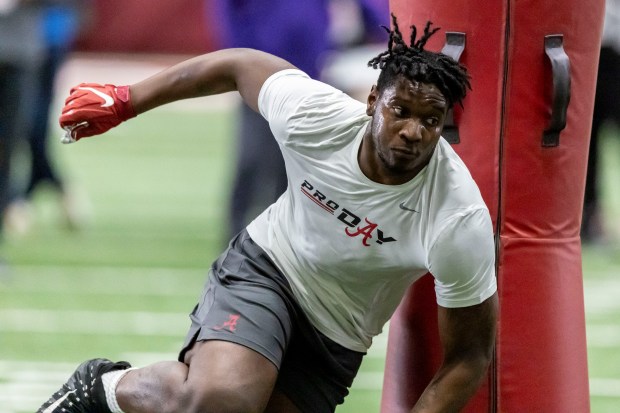The greatest motivation for the Chicago Bears to swap a fourth-round draft pick for wide receiver Keenan Allen was the idea he can be a multiplier for the offense, just as edge rusher Montez Sweat was for the defense when the Bears acquired him in October.
Allen is a high-level route runner with a feel for how to get open — a perfect outlet for a rookie quarterback with all signs pointing to the Bears using the No. 1 pick on USC’s Caleb Williams.
An additional benefit of the deal — which for now is a one-year rental, similar to what the Houston Texans did in dealing for wide receiver Stefon Diggs with the Buffalo Bills — is it gives general manager Ryan Poles extra flexibility with the ninth pick.
Without Allen, the Bears would have had a serious need for a No. 2 wide receiver opposite DJ Moore. Now they still can look in that direction with an eye toward the future if Marvin Harrison Jr., Rome Odunze or Mailk Nabers is available, or they could pivot to an offensive tackle or edge rusher. There’s also a trade-down scenario if the right partner emerges, but that’s a story for another day.
It stands to reason the Bears’ primary goal with the ninth pick should be to acquire a premium talent. They don’t plan on having a high pick again in 2025, and a roster that has undergone a major overhaul the last two-plus years still needs more high-end talent — or “blues,” as scouts call them.
It’s worth exploring how the Bears evaluate left tackle Braxton Jones’ career arc entering Year 3 versus the talent available in the draft at that position. And they certainly could use another defensive end opposite Sweat. The Bears had 10 sacks through eight games before acquiring Sweat from the Washington Commanders for a second-round pick, then had 20 sacks in the final nine games.
So a solid case can be made that edge rusher is a legitimate need for Matt Eberflus’ defense with Sweat, DeMarcus Walker and Jake Martin the top options right now. Alabama’s Dallas Turner, Florida State’s Jared Verse, UCLA’s Laiatu Latu and Penn State’s Chop Robinson are the edge rushers mentioned most prominently as potential first-round picks.
It’s not a great draft for pass rushers, and it’s possible only one or perhaps even none goes in the top 10 picks. That doesn’t mean there aren’t options if the Bears don’t select one in Round 1. They currently have four total picks, including No. 75 (the 11th pick in Round 3) and No. 122 (the 22nd pick in Round 4).
After talking with multiple scouts and considering traits that are important to Eberflus, here are eight options the Bears could consider if they are searching for an edge rusher after Round 1.
Chris Braswell, Alabama, 6-foot-3, 251 pounds
Braswell has been overshadowed somewhat by Turner, but he performed pretty well at the scouting combine, running the 40-yard dash in 4.6 seconds with a 10-yard split of 1.59. He has decent length with 33¼-inch arms.
“He’s really good off the football and has some real juice,” one scout said. “Good, quick first step and he can create conflict immediately for an offensive tackle. He’s got enough bend to sink and turn the corner.”
Braswell probably won’t last until No. 75, so the Bears likely would have to consider trading into Round 2 if they’re intent on getting a player who’s close to NFL-ready.
“He’s got a more versatile rush plan than most of these guys you’re talking about after Round 1 because he’s coming from Alabama. Well-coached,” the scout said.
Marshawn Kneeland, Western Michigan, 6-3, 267
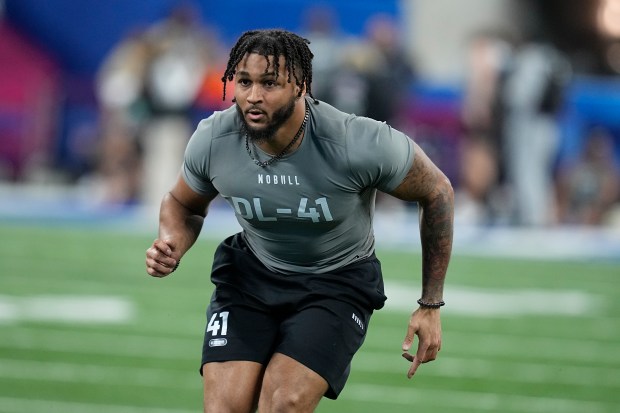
Kneeland possesses ideal size and good length with 34½-inch arms. He ran a 4.75-second 40 at the combine with a solid 20-yard shuttle of 4.18. He’s very powerful at the point of attack.
“Can bull rush, has excellent pursuit ability and advanced hands with lower-body quickness,” a scout said. “Kneeland can redirect and change directions. Once he gets to the NFL, he’s going to learn he can’t win with power the same way he did in the MAC. He’s going to have to show he can develop more pass-rush tools.”
Like Braswell, Kneeland might be a long shot to make it to No. 75, but the combination of size and power makes him worth examining.
Adisa Isaac, Penn State, 6-4, 247
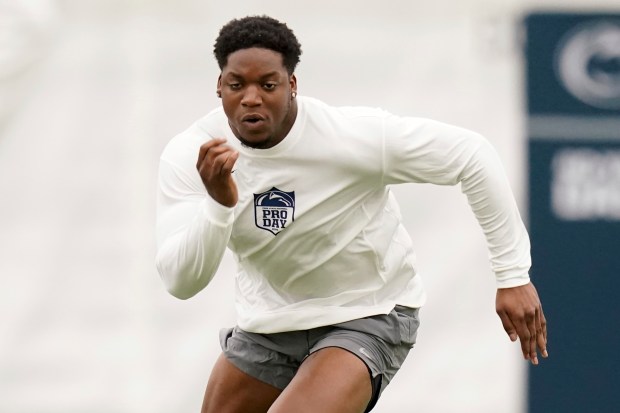
Isaac had marginal testing numbers at the combine but has really good length with 33 7/8-inch arms and a lower body that can be developed in the weight room.
“High football intelligence and he makes a lot of plays where he slips into the backfield, and you can tell in a lot of cases that’s because he was able to diagnose pre-snap what was happening,” a scout said. “He doesn’t get talked about enough because he played with Chop Robinson, but he’s technically sound and strong with his hands. Quick first step off the ball and he has the foot speed to redirect and chase down plays from behind. Needs a little more thickness.”
Isaac had solid production for the Nittany Lions with 7½ sacks last season, and Penn State produces a lot of athletic performers.
Mohamed Kamara, Colorado State, 6-1, 248
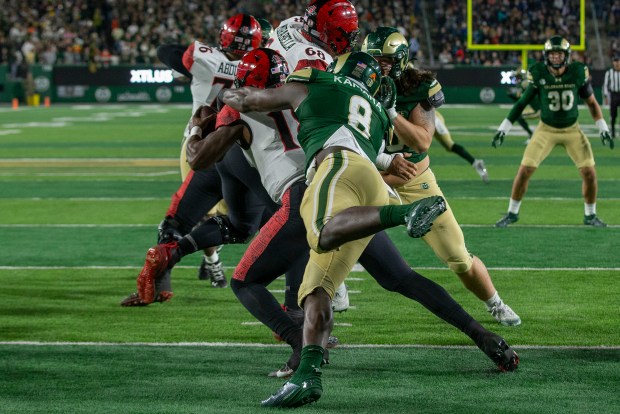
Kamara had tremendous production for the Rams with 30½ sacks, 45½ tackles for a loss and five forced fumbles in 49 career games. Some teams will be very curious about Kamara because of his production and high effort, and others will be turned off because he comes in a different shape than your traditional edge rusher.
If the Bears don’t get hung up on Kamara’s lack of length — his arms are only 32 3/8 inches — they might view him as a perfect fit for Eberflus’ HITS system. Kamara ran well in Indianapolis with a 4.57 in the 40 and had a broad jump of 10 feet, 3 inches.
“He’s kind of built like a bouncer, the last guy you want to tussle with at a bar,” a scout said. “NFL comps for him are going to be maybe Carl Lawson or one guy mentioned Elvis Dumervil. He plays every play like he’s being evaluated for a job. Plays extremely hard and he’s not only powerful, he’s violent.
“Can turn the corner and he’s slippery on contact. He can get under the pads of a lineman and drive them back. Not a lot of length, so you wonder how he’s going to hold up against the run in the NFL. But he never stops playing. Interesting guy.”
Austin Booker, Kansas, 6-4, 240
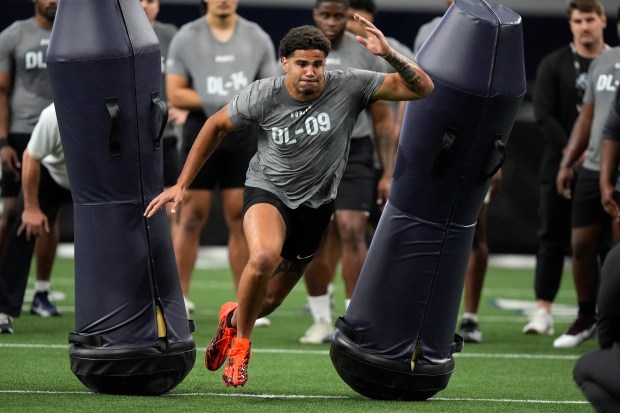
As a redshirt sophomore last season, Booker had eight sacks for the Jayhawks after transferring from Minnesota. While he had a good week of practice at the Senior Bowl, the combine was a disappointment when he ran the 40 in 4.79.
“Really didn’t test well,” one scout said. “But he’s got an impressive ability to rush from speed to power and has a nice collection of moves. Great wing span with 33 7/8-inch arms and a long body. He can chase down plays from behind, and with this kid, you’ve got to go back to the tape to see if he’s faster than the combine times would lead you to believe.
“He’s going to need to get bigger and stronger, but he’s pretty refined as a rusher for a lack of experience. I’m stunned he ran so poorly and I wonder if Booker would have been better off staying in school for another year.”
Jonah Elliss, Utah, 6-2, 248
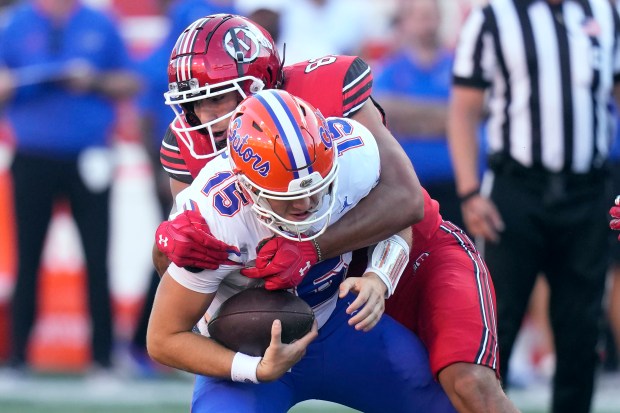
The son of former Lions standout defensive tackle Luther Elliss, Jonah Elliss led the Utes with 12 sacks last season. He needs to get a little bigger and definitely stronger.
“Multiple counters and slippery on contact. Elliss has some lower-body quickness,” a scout said. “He’s more of a skilled rusher than anything else, and you have to ask yourself: ‘Has he capped out? How much more does he have to grow?’
“He’s not super twitchy like some of these other kids, but that’s what you wind up looking at when it gets to Day 3 a lot of the time. He can attack the edge but he’s got to get a stronger base.”
Bralen Trice, Washington, 6-3, 245

A team captain for the Huskies, Trice had seven sacks and 11½ tackles for a loss last season after posting nine sacks as a junior.
“Very competitive player,” a scout said. “Not a lot of high-level traits though. But he’s super tough and plays with the kind of style that would fit Eberflus. High motor but he’s got tight hips, a tight lower body and we’re not talking about a souped-up athlete. If they’re looking for speed off the edge, not sure this is the guy, but he’s a heck of a football player.”
Jalyx Hunt, Houston Christian, 6-4, 252
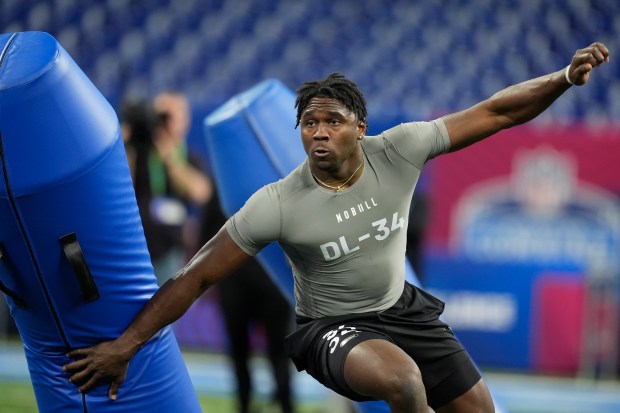
Hunt is a developmental prospect who tested well in Indianapolis with a 4.64 in the 40 to go with a 37½-inch vertical and 10-8 broad jump. He also put up 19 reps on the bench press at 225 pounds, impressive for a guy with 34 3/8-inch arms.
The Southland Conference Defensive Player of the Year last season, Hunt had 13½ sacks. He began his college career as a safety at Cornell.
“No question he needs to add some thickness to his frame,” a scout said. “Their biggest game was Western Kentucky and he flashed with some splash plays. Hunt has all the tools you’re looking for from a developmental standpoint. Great range. No question he can bend off the edge.
“He’s too tall at the point of attack and is going to need some coaching, learn how to play with leverage. He’s fun to watch. Someone is going to really believe he’s got a chance to grow, but this has Day 3 pick written all over it.”


